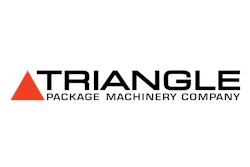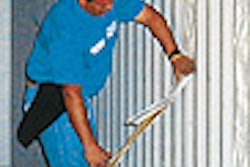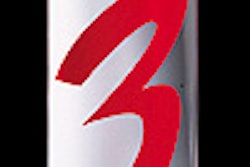
The labels that decorate the bottles shown here exhibit a uniqueness as intriguing as the wines themselves. It’s no wonder the Tag and Label Manufacturing Institute (Naperville, IL) honored so many wine labels among its 34 North American winners in this year’s competition.
Seven wine labels were honored with First Place awards in the North American division. To compete, entrants must be converters and members of the TLMI organization. Labels, tags, cartons, and flexible packaging are judged based on technical excellence, overall printing quality, production (converting complexity), and function.
This year’s entries ranged from front and back labels for household cleaning fluids to cartons for personal care products. The winning wine labels employ creative decorative techniques and subtle graphics. Steve Lee, awards chairperson at TLMI, says that he expects wine and spirits labels to continue to excel at the TLMI awards.
“The wineries demand a higher-end label,” Lee says. “Some of the labels are absolutely beautiful. Some of them are reproductions of paintings.”
Lee says that next year, contest organizers plan on adding a special wine and spirits division to the TLMI awards. Because of the high-quality demands that the wineries have, their labels are almost unfair competition against day-to-day labels judged in other categories, he adds.
Symmetrical label
In keeping with its shapely moniker, Symmetry, the Alexander Valley red table wine from Rodney Strong Vineyards (1), is decorated with a triangle-shaped label that embodies aspects of both the name and the richness of the wine itself. The deep brown and black pressure-sensitive paper label is trimmed with a delicate dotted line that accentuates its angular shape.
“The look reflects exactly what the wine itself tastes like,” says a representative at Healdsburg, CA-based Rodney Strong Vineyards. “The deep, rich flavor is captured in the label.”
Designed in conjunction with Powers Creative (Windsor, CA), the front label is half black, half brown. A yin-yang-shaped symbol is poised in the top-center portion of the label. It’s embossed in gold with half of its interior colored brown, the other black. The brand name is also embossed in gold, while the remaining text is bronze.
The subtle coloring and foil stamping were executed by converter Tapp Technologies Inc. (Langley, British Columbia, Canada). Tapp earned four awards in all at this year’s competition, winning First Place for the Symmetry label.
Tapp offset-prints the label in three colors plus a waterless UV varnish. The label is also foil-stamped and embossed.
Rustic image
The award-winning labels for Niebaum-Coppola’s Merlot (2) are designed in part by the winery’s owner, acclaimed film director Francis Ford Coppola. Both front and back labels have a rustic, antique sensibility. But it was the back label that won in the TLMI competition.
“We were worried about quality,” says Jason Curtis, package and production coordinator for Niebaum-Coppola Vineyards. “We wanted to maintain our image.”
To help emulate the quality of the wine in the look of the label, the vineyard turned to Tapp Technologies. Joining in the creative process was Café Greco Design (New York, NY). The parchment-colored p-s label is printed offset in four colors with a UV varnish. Vintage, additional description, and government warning are printed over the subtle image of an ornate diamond and other shapes. A red line traces the label’s border.
Niebaum-Coppola wines are produced at its Rutherford, CA, estate in low volumes. Many are available only in California and surrounding western states. However, the Merlot is distributed nationally and retails in wine and liquor stores for $45 to $50.
Label tells a story
Relatively new to the wine-making industry, Stolpman Vineyards (3) in Rancho Palos Verdes, CA, sought to develop a strong identity for its wines by creating a label that captures the look and feel of its expansive vineyards.
“We came up with a concept that gave us the strong identity and name, strength and solidity, as well as a look at our scenic vineyards,” says owner Tom Stolpman. “We wanted to tell our story as well as the story of the wine.”
CALabel (San Luis Obispo, CA), a div. of W/S Packaging, won a First Place award for its work on Stolpman’s 1998 Sangiovese label. The label is UV-flexo printed on metallized paper stock. According to the converter, it was difficult to achieve a smooth ink laydown because, in addition to the metallized paper, they also used two metallic gold stamps.
Designed by Axion Design (San Anselmo, CA), the label features an oak tree that Stolpman says “identifies the brand and reflects a sense of quality through elegance.”
Stolpman says that he chose to work with CALabel because he was impressed with the work it had done for other wineries. He wanted a converter with a good track record and the right machinery to create the type of label he had in mind.
Stolpman’s Sangiovese is available nationally through limited distribution.
Graphics prove challenging
The rustic feel that is expressed through the label for Castoro Cellars’ Cabernet Sauvignon (4) is attained through grainy paper stocks and understated graphics. The Templeton, CA-based winery decorates its labels with a product-identifying beaver, representative of the winery’s name, Castoro, which is Italian for beaver.
Again CALabel was recognized this time for the vintage’s back label, winning a First Place award. A map on the label that identifies the vineyard’s location proved challenging for the converters, requiring special attention to maintain tight registration between brown to yellow areas and a bronze foil stamp.
The label, designed by Tharp Did It (Los Gatos, CA), was printed UV-flexo with a hot-foil stamp.
Castoro Cellars’ wines are available in 11 states and nine different countries. Bottles of the Cabernet Sauvignon retail for $14.
Awards recognize innovation
Other awards recognized labels from Robert Mondavi, Mission Hill Family Estate, and W Weinstock vineyards. The cork/cap p-s label (5) on bottles of Mondavi’s Woodbridge won a First Place for Spectrum Label Corp. (Hayward, CA). According to the converter, this project posed a challenge due to the tag substrate surface. A hot-stamp foil transfer required extensive research and development to achieve acceptable printing quality, the company says. The cap label is flexo-printed.
Tapp Technologies won another First Place award for its work on the neck label for W Weinstock Vineyards. The label is UV-offset printed in four colors with gold foil stamping plus an aqueous coating.
The labels for Mission Hill Family Estates’ 1999 Syrah (6) are also converted by Tapp Technologies. Printed UV-offset, the labels feature two colors plus gold foil and embossing on an uncoated vellum stock.
In summarizing this year’s awards selections, TLMI’s Lee notes that competition was pretty tight between entries. He says it’s difficult distinguishing an award winner from other stellar labels. And he anticipates the judging will become more difficult next year. “The quality just keeps getting better and better,” he says.


























